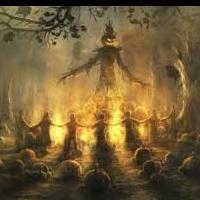Halloween Origins 8: Matchmaking
||Сватовство
||Matchmaking
||Matchmaking
Halloween is an annual holiday celebrated each year on October 31, and Halloween 2018 occurs on Wednesday, October 31.
It originated with the ancient Celtic festival of Samhain, when people would light bonfires and wear costumes to ward off ghosts.
|||||Celtic||||||||bonfires|||||||
In the eighth century, Pope Gregory III designated November 1 as a time to honor all saints; soon, All Saints Day incorporated some of the traditions of Samhain.
||||||||||||||||||||włączył||||||
The evening before was known as All Hallows Eve, and later Halloween.
Over time, Halloween evolved into a day of activities like trick-or-treating, carving jack-o-lanterns, festive gatherings, donning costumes and eating sweet treats.
|||evolved||||||||||carving|||lanterns||||||||
|||||||||||||||||||zakładania|||||
a través de||||||||||||||||||||||||
Halloween Matchmaking: But what about the Halloween traditions and beliefs that today's trick-or-treaters have forgotten all about?
|сватовство|||||||||||||дразнилки||||
||||||||||||truco||trick-or-treaters||||
|配对|||||||||||||||||
Согласование на Хэллоуин: Но что насчет традиций и верований на Хэллоуин, о которых сегодняшние «сладости или гадости» забыли?
Many of these obsolete rituals focused on the future instead of the past and the living instead of the dead.
|||过时的|仪式|||||||||||||||
|||obsolete||||||||||||||||
||||||||||||||||en lugar|||muertos
|||przestarzałych||||||||||||||||
||||ритуалы|||||||||||||||
Множество из этих устаревших ритуалов сосредоточивались на будущем, а не на прошлом, и на живых, а не на мёртвых.
In particular, many had to do with helping young women identify their future husbands and reassuring them that they would someday — with luck, by next Halloween — be married.
|||||||||||||||успокаивая|||||когда-нибудь|||||||
||||||||||identify|||||reassuring||||||||||||
|||||||||||||||uspokojenie||||||||||||
В частности, многие из них были связаны с тем, чтобы помочь молодым женщинам выявить своих будущих мужей и заверить их в том, что однажды — с удачей, к следующему Хэллоуину — они выйдут замуж.
In 18th-century Ireland, a matchmaking cook might bury a ring in her mashed potatoes on Halloween night, hoping to bring true love to the diner who found it.
|||||||||||||土豆泥|||||||||||||||
|||||||||||||mashed|||||||||||||||
|||||||||||||||||||||||||diner|||
||||||||enterrar|una|anillo|||puré|||||||||||||||
В Ирландии XVIII века повар-сват пытался укрыть кольцо в своем картофельном пюре в Хэллоуин, надеясь, что оно принесет настоящую любовь тому, кто его найдет.
In Scotland, fortune-tellers recommended that an eligible young woman name a hazelnut for each of her suitors and then toss the nuts into the fireplace.
|||гадалки|рекомендовали|||||||||||||женихов||||||||
||||recommended|||eligible||||||||||||||||||
||wróżki|||||kwalifikująca się|||||orzech|||||zalotników|||wrzucić|||||
|||||||合适的|||||榛子|||||追求者||||||||火炉
В Шотландии гадалки советовали незамужней девушке назвать лешку для каждого из своих ухажеров, а затем бросить орехи в камин.
The nut that burned to ashes rather than popping or exploding, the story went, represented the girl's future husband.
Орех, который сгорел до пепла, а не лопнул или взорвался, как говорили, символизировал будущего мужа девушки.
(In some versions of this legend, the opposite was true: The nut that burned away symbolized a love that would not last.)
|||||||||||||||символизировала||||||
Another tale had it that if a young woman ate a sugary concoction made out of walnuts, hazelnuts and nutmeg before bed on Halloween night she would dream about her future husband.
|сказание|||||||||||||||грецких орехов|фундука||мускатный орех||||||||||||
|||||||||||słodką|mikstura||||orzechy włoskie|orzechy laskowe||gałka muszkatołowa||||||||||||
|||||||||||甜的|混合物||||核桃|榛子||肉豆蔻||||||||||||
Еще одна история гласила, что если молодая женщина перед сном в ночь Хэллоуина съест сладкую смесь из грецких орехов, фундука и мускатного ореха, она будет видеть во сне своего будущего мужа.
Young women tossed apple-peels over their shoulders, hoping that the peels would fall on the floor in the shape of their future husbands' initials; tried to learn about their futures by peering at egg yolks floating in a bowl of water; and stood in front of mirrors in darkened rooms, holding candles and looking over their shoulders for their husbands' faces.
||||кожуры||||||||||||||||||||||||||будущего|||||желтков||||||||||||||||||||||||||
||||||||||||||||||||||||initials|||||||||||yolks||||||||||||||||||||||||||
||lanzaban||cáscaras|||hombros|||||||||||||||||||||||||||||||||||||||||||||velas|||||||||
||rzuciły||||||||||||||||||||||||||||||patrzeniu|||żółtek||||||||||||||||||||||||||
||||||||||||||||||||||||首字母||||||||窥视|||黄蛋|||||||和|||||||||||||||||||
Молодые женщины бросали яблочные корки через плечо, надеясь, что корки упадут на пол в форме инициалов их будущих мужей; пытались узнать о своем будущем, заглядывая в яичные желтки, плавающие в чашке с водой; и стояли перед зеркалами в затемненных комнатах, держа свечи и глядя через плечо в поисках лиц своих мужей.
Other rituals were more competitive.
||||competitive
Другие ритуалы были более конкурентными.
At some Halloween parties, the first guest to find a burr on a chestnut-hunt would be the first to marry; at others, the first successful apple-bobber would be the first down the aisle.
||||||||||刺球|||栗子||||||||||||||苹果浮子|||||||走道
|||||||||||||||||||||||||||bobber|||||||
||||||||||burr|na||kasztan|polowanie||||||||||||||||||||aisle
|||||||||||||||||||||||||||пловец яблок|||||||
На некоторых Хэллоуинских вечеринках первый гость, который найдет ершик на охоте за каштанами, будет первым, кто вступит в брак; на других - первым, кто успешно поймает яблоко, будет первым, кто пойдет по алтарю.
在一些万圣节派对上,第一个在栗子狩猎中找到刺球的客人将是第一个结婚的人;在其他派对上,第一个成功捞苹果的人将是第一个走上红毯的人。
Of course, whether we're asking for romantic advice or trying to avoid seven years of bad luck, each one of these Halloween superstitions relies on the goodwill of the very same “spirits” whose presence the early Celts felt so keenly.
|||||||||||||||||||||||зависит|||доброжелательности|||||||||||||
|||||||||||||||||||||||||||||||||||||||keenly
||||||||||||||||||||||||||dobroci|||||||||||||ostro
Конечно, независимо от того, запрашиваем ли мы романтические советы или пытаемся избежать семи лет неудач, каждая из этих хэллоуинских суеверий зависит от доброй воли тех же самых «духов», чье присутствие ранние кельты чувствовали так остро.
当然,无论我们是在寻求浪漫建议还是试图避免七年的霉运,这些万圣节迷信都依赖于同样“灵魂”的善意,而早期的凯尔特人对此感受得尤为强烈。

